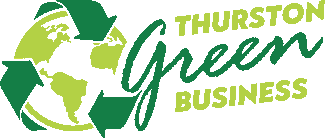by Ramsey Zimmerman – Program Director for Thurston Energy
I’ve been thinking about “Influence” lately. As in “Who do we have influence with and who has influence with us?”. I was thinking about it in the context of our organization. I realized that the same situation applies to any organization. So I dashed off a quick diagram. Here’s my Organizational Influence Model:

Let’s think about it in terms of an organization that cares about energy efficiency and renewable energy (let’s just say energy) and wants to do something about it.
That organization can take action within its facility or operations to reduce energy usage. That will have operational cost reduction benefits that will pay dividends for the investment. But that investment can have two additional benefits that come from sources outside the organization: 1) the kudos or recognition that the company can get for taking action, and 2) the inspiration of others to take similar actions as a result of the influence that the organization has on others.
So now we get to the notion of an organization’s influence.
On the horizontal line of the model, we see a representation of social influence. An organization is made up of owners, employees, and/or volunteers that come to work there. Likewise, an organization speaks to and may be noticed by the public, the media (news and otherwise), and the social networks that it exists in. An organization that takes action on energy can tell its story and be an inspiration over both of these sets of people. Likewise, it can encourage and even reward similar energy saving behavior by celebrating employees’ successes saving energy at home, giving educational advice in employee newsletters, and sending out press releases to the media or to social networks explaining the organization’s actions so that others might do the same.
On the vertical part of the model, we see a representation of business influence. An organization buys from some combination of service providers, suppliers, and/or private contractors. Likewise, an organization sells to or serves customers or clients. With these folks, an organization has influence because of a stream of dollars, but in most cases that comes with respect, familiarity, and working relationships (hopefully). An organization can say to a supplier: “We’re taking action to save energy and money. How about you?” Depending on the dollar amounts that the organization spends with that supplier, they may be able to directly influence or even demand that suppliers take certain actions to keep up. On the downstream side, organizations can report to their customers or clients the ways in which they are taking proactive steps to reduce their energy use and be good stewards of limited resources. Some people actually buy more from responsible companies. Really!
I know this stuff is not rocket science or even anything new … we see it all the time, especially from big companies. When you get packages in the mail, the shipper might put in a special label telling you about the biodegradable cornstarch packing peanuts they used (I’m still waiting for the one that says “Just pour milk on them! Part of this nutritious balanced breakfast!”). And the company employee e-newsletter might talk about the latest project that the company did in the Des Moines office.
The message here is that the actions taken by organizations do not happen in a vacuum. Positive actions like saving energy and saving money at the office can be channeled to have cascading positive impacts outside the organization that result in good P.R. for the organization, more energy and money savings by private individuals and other organizations, and it can even make a pretty cool little model I can publish on my blog. Just don’t pour milk on it, I don’t want the model to break down.
